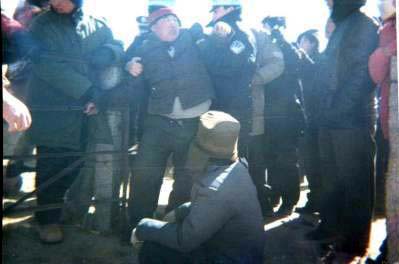|
2005.02.07
By: RFA correspondent
Gardi Borjigin
 |
|
|
Many ethnic Mongolian herders were beaten up and arrested by
the police during the displacement in eastern Inner
Mongolia’s Bagarin (Bairin) Right Banner. For more photos
click here. (photo provided
and posted by SMHRIC)
|
|
HOHHOT,
Inner Mongolia—In a desperate bid to save Inner Mongolia’s
environment, the Chinese government has begun relocating more
than 250,000 nomads from the rugged pastures they have roamed
for centuries.
The
government maintains that taking care of the environment will
ultimately protect the herders’ livelihoods.” The herders,
however, see this new “environmental immigration” as further
marginalizing a Mongolian nomadic minority already vastly
outnumbered by Chinese peasants.
Since
1949, Inner Mongolia’s population has soared sixfold from 5.6
million to 32 million—with more and more farm animals as well.
The environmental strain, worsened by years of overzealous
tree-cutting and overgrazing, is turning an additional 386
square miles of Inner Mongolian grassland to desert each year.
Major losses, but of whose making?
The
U.N. Environment Programme estimates direct economic losses from
environmental damage in the whole of China at $6.5 billion
annually, and the Chinese government is working feverishly to
contain the problem.
That
means little, however, to the nomadic herders of Inner Mongolia,
who see the issue as a problem of the government’s own making
after years of government-sanctioned Han Chinese immigration to
the region.
“Local
government officials came and told us to move away this spring.
They said we cannot return to our land for 10 years,” said
Bayanduuren, an elderly herder from the Alasha region.
“We
have no home, no business, and don’t know where to go. After 10
years I hope that I can return to my birthplace, but I’m not
sure if I will be alive by that time. I don’t know. The future
is so unclear,” he said.
In some
areas, relocation meets with stiff resistance from herders, and
local officials resort to police force to chase the herders
away.
Resistance from herders
The
Southern Mongolian Human Rights Information Center, a New
York-based group, has reported clashes between local herders and
police in Bagariin Banner in eastern Inner Mongolia in May 2001.
“Nearly
100 policemen and security officers fought with bare-handed
herders. Forty-one animals were confiscated, and four people
were beaten up and seriously injured when the policemen tried to
confiscate their livestock,” a witness said.
“In
order to move by a very close deadline, we had to tear down
livestock shelters and homes and sell our livestock at very low
prices. Because of the shortage of facilities and other
infrastructure, it is extremely hard to make a living in the new
place,” the witness said.
‘A
tiny hut’ in return
An
Uzemchin tribe herder from the Shiliin Gol League said officials
“force us to abandon our land for three to five years. What they
offer in exchange is a tiny hut in a town suburb and a one-time
payment for the land ownership rights.”
“If one
wants to retain rights to the pasture, one is not given any
money at all. I don’t know what to do,” the Uzemchin herder said
on condition that he remain anonymous.
Another
herder from the Shiliin Gol League echoed his account.
“I saw
the homes they build for resettlers. They are too small, just
like a matchbox. The kitchen is the size of a cupboard. I have
three children. We simply cannot fit in,” the second herder
said.
“Even
if I move in and decide to buy one milking cow, this alone will
cost three times what they offer as compensation for the land,”
he said.
Hundreds of thousands said to be moved
The
Southern Mongolian Human Rights Information Center estimates
that up to 650,000 nomadic people will be removed from their
traditional pasturelands over the next few years.
“Most
[migrants] are not properly provided for with food, water,
housing, shelter, and medical services by the government,” the
group said.
“Most…were resettled to agricultural or urban areas with a
dominant Han Chinese population, with no suitable social,
cultural, and language environment for ethnic Mongolians, and
are being forced to engage in business and agricultural
lifestyles instead of their traditional nomadic way of life.”
Currently, ethnic Mongols represent a tiny 17 percent of the
Inner Mongolia Autonomous Region’s 23 million people, the
overwhelming majority of whom are Han Chinese. |





